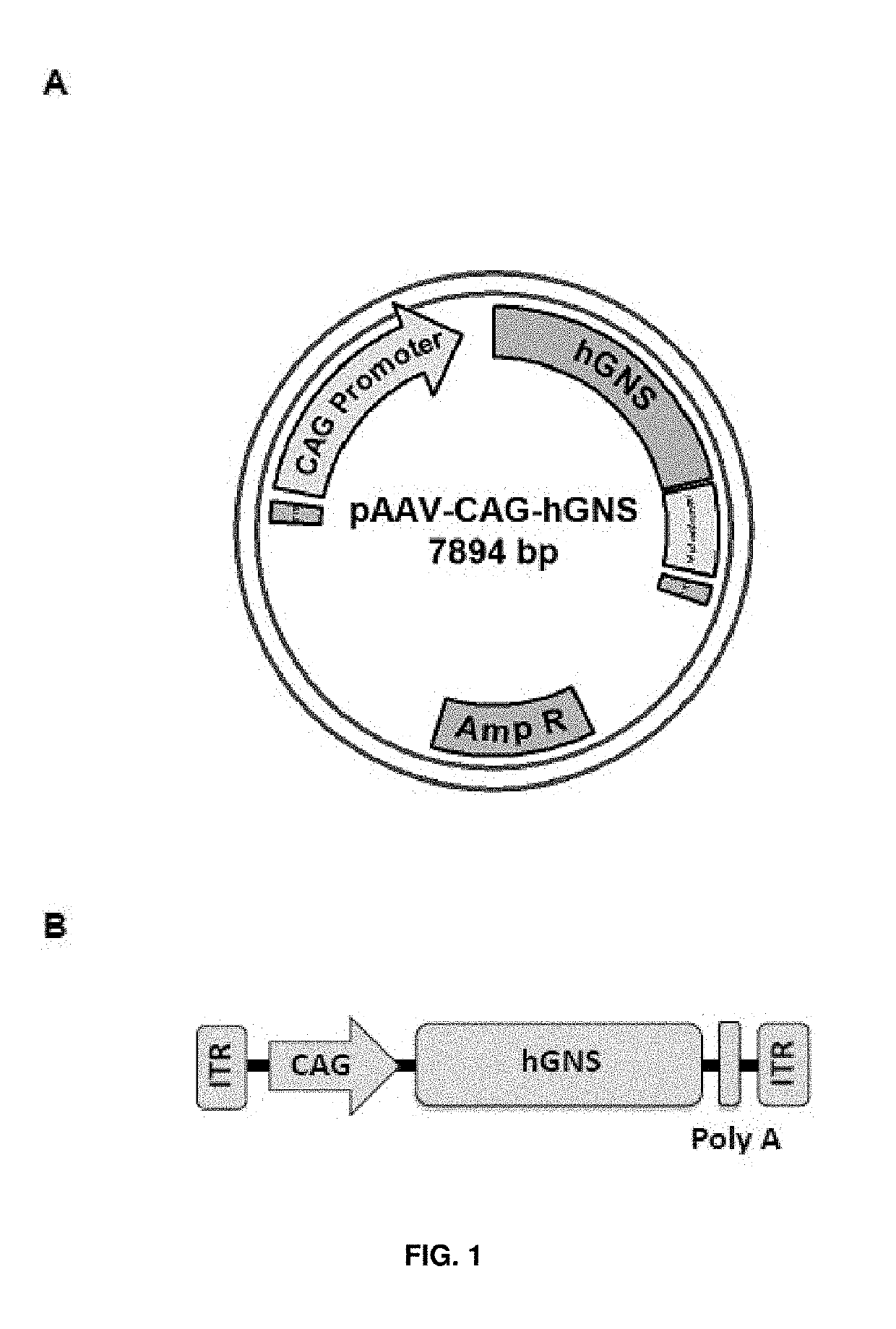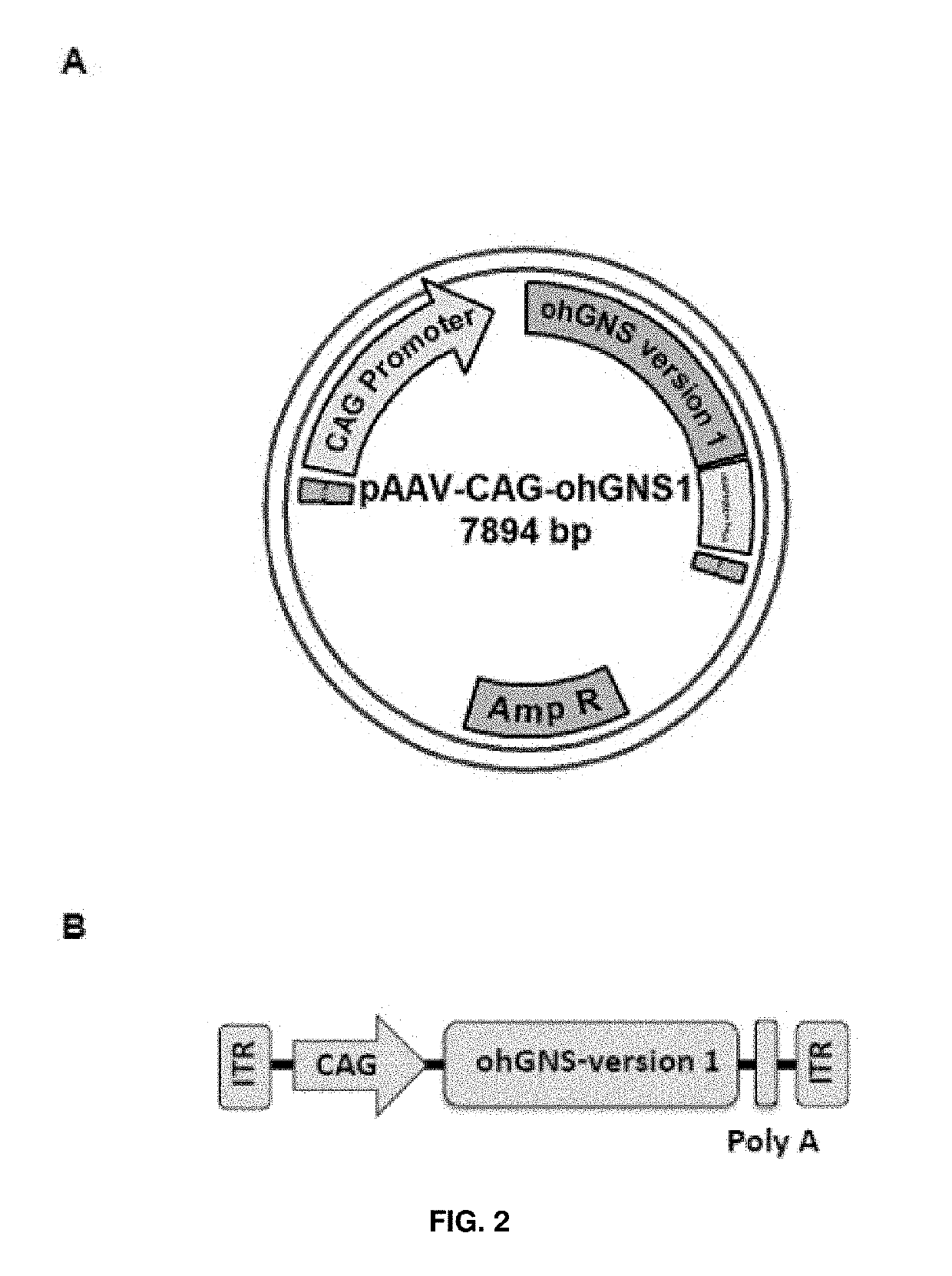Adenoassociated virus vectors for the treatment of mucopolysaccharidoses
a technology of adenoassociated virus and mucopolysaccharidose, which is applied in the field of polynucleotides and vectors, can solve the problems of affecting the general population, normal activity, and medical support needs to be availabl
- Summary
- Abstract
- Description
- Claims
- Application Information
AI Technical Summary
Benefits of technology
Problems solved by technology
Method used
Image
Examples
example 1
ion of pAAV-CAG-hGNS
[0186]The CDS for human glucosamine (N-acetyl)-6-sulfatase (NCBI Reference Sequence: NM_002076.3) was used as starting material and was chemically synthetized for this purpose (GeneArt; Life Technologies). The CDS was received cloned inside the plasmid pMA-RQ (AmpR) flanked by MluI and EcoRI restriction sites at 5′ and 3′, respectively.
[0187]The MluI / EcoRI human glucosamine (N-acetyl)-6-sulfatase CDS fragment was excised from the pMA-RQ plasmid and subsequently cloned between the MluI and EcoRI restrictions sites of the AAV backbone plasmid pAAV-CAG. The resulting plasmid was named pAAV-CAG-hGNS (accession number DSM 32342). See FIG. 1A and SEQ ID NO: 5.
[0188]The AAV backbone plasmid pAAV-CAG used herein had been previously generated and contained the ITRs from the AAV2 genome, the CAG promoter, and the polyA signal from rabbit β-globin, as well as a multicloning site for cloning of CDSs of interest. The CAG promoter is a hybrid promoter composed of the CMV early...
example 2
ion of pAAV-CAG-ohGNS-Version1
[0189]Expression cassettes including an optimized version of glucosamine (N-acetyl)-6-sulfatase cDNA sequence (ohGNS) were designed and obtained. The sequence optimization was performed to maximize the efficiency of N-acetylglucosamine 6-sulfatase protein production in human beings through elimination of cryptic splice sites and RNA destabilizing sequence elements for increased RNA stability, addition of RNA stabilizing sequence elements, codon optimization and G / C content adaptation, avoidance of stable RNA secondary structures amongst others changes. The CDS for human glucosamine (N-acetyl)-6-sulfatase (NCBI Reference Sequence: NM_002076.3) was used as starting point for sequence optimization.
[0190]The first optimized CDS (GeneArt; Life Technologies) was received cloned inside the plasmid pMA-T (AmpR) flanked by MluI and EcoRI restriction sites at 5′ and 3′, respectively.
[0191]The MluI / EcoRI optimized human glucosamine (N-acetyl)-6-sulfatase CDS fragm...
example 3
ion of pAAV-CAG-ohGNS-Version2
[0192]The CDS for human glucosamine (N-acetyl)-6-sulfatase (NCBI Reference Sequence: NM_002076.3) was subjected to sequence optimization (DNA2.0 Inc). The optimized CDS was received cloned inside the plasmid pJ204 (AmpR) flanked by MluI and EcoRI restriction sites at 5′ and 3′, respectively.
[0193]The MluI / EcoRI optimized human glucosamine (N-acetyl)-6-sulfatase CDS fragment was excised from the pJ204 plasmid and subsequently cloned between the MluI and EcoRI restrictions sites of the AAV backbone plasmid pAAV-CAG. The resulting plasmid was named pAAV-CAG-ohGNS-version2 (accession number DSM 32344). See FIG. 3A and SEQ ID NO: 7.
PUM
 Login to View More
Login to View More Abstract
Description
Claims
Application Information
 Login to View More
Login to View More - R&D
- Intellectual Property
- Life Sciences
- Materials
- Tech Scout
- Unparalleled Data Quality
- Higher Quality Content
- 60% Fewer Hallucinations
Browse by: Latest US Patents, China's latest patents, Technical Efficacy Thesaurus, Application Domain, Technology Topic, Popular Technical Reports.
© 2025 PatSnap. All rights reserved.Legal|Privacy policy|Modern Slavery Act Transparency Statement|Sitemap|About US| Contact US: help@patsnap.com



